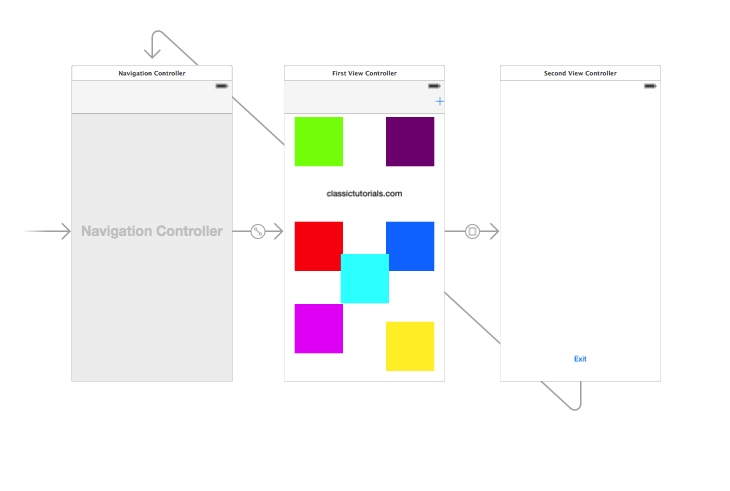
Creating Frosted Glass effect using Swift - ios 7/ios 8 - Xcode 6



override func prepareForSegue(segue: UIStoryboardSegue!, sender: AnyObject!) {
println("Entering prepareForSegue")
var secondView:SecondViewController = segue.destinationViewController as SecondViewController;
var snapshotView:UIView = view.snapshotViewAfterScreenUpdates(true)
UIGraphicsBeginImageContextWithOptions(view.bounds.size, true, 0.0)
snapshotView.drawViewHierarchyInRect(view.bounds, afterScreenUpdates: true)
var imgaa :UIImage = UIGraphicsGetImageFromCurrentImageContext();
var ciimage :CIImage = CIImage(image: imgaa)
var filter : CIFilter = CIFilter(name:"CIGaussianBlur")
filter.setDefaults()
filter.setValue(ciimage, forKey: kCIInputImageKey)
filter.setValue(30, forKey: kCIInputRadiusKey)
var outputImage : CIImage = filter.outputImage;
var finalImage :UIImage = UIImage(CIImage: outputImage)
secondView.background = finalImage
UIGraphicsEndImageContext();
println("Exit prepareForSegue")
} Let me explain what each part do.
var secondView:SecondViewController = segue.destinationViewController as SecondViewController;
The above code is used to access the destination View controller. The data will be passed to it.
var snapshotView:UIView = view.snapshotViewAfterScreenUpdates(true) UIGraphicsBeginImageContextWithOptions(view.bounds.size, true, 0.0) snapshotView.drawViewHierarchyInRect(view.bounds, afterScreenUpdates: true) var imgaa :UIImage = UIGraphicsGetImageFromCurrentImageContext();In the above code we take a screen shot of the first view and change it to UIImage.
var ciimage :CIImage = CIImage(image: imgaa) var filter : CIFilter = CIFilter(name:"CIGaussianBlur") filter.setDefaults() filter.setValue(ciimage, forKey: kCIInputImageKey) filter.setValue(30, forKey: kCIInputRadiusKey) var outputImage : CIImage = filter.outputImage;
Here we have created a CIFilter and applied CIGaussianBlur on the image which we have taken screenshot.
Note that you can modify the
kCIInputRadiusKey
value to set the amount of blur.
Finally we set the blur image to our second view controller as follows
secondView.background = finalImage UIGraphicsEndImageContext();Step 3: In the second view controller we will use this image as background.
class SecondViewController: UIViewController {
var background :UIImage = UIImage.alloc()
override func viewDidLoad() {
super.viewDidLoad()
var imageView: UIImageView = UIImageView(image: background)
imageView.frame = CGRectMake(0, 0, view.frame.size.width, view.frame.size.height)
self.view.addSubview(imageView)
//Adding some text over the semi transperent overlay
var plainUIView :UIView = UIView(frame: CGRect(x: 0, y: 100, width: 320, height: 200))
plainUIView.backgroundColor = UIColor.whiteColor()
var someText :UILabel = UILabel(frame: CGRect(x: 0, y: 130, width: 320, height: 50))
someText.numberOfLines = 2
someText.text = "I can write or put anything here. n @Classic Tutorials"
plainUIView.addSubview(someText)
self.view.addSubview(plainUIView)
}
}If you want to play around with the brightness or glare of the background blur you can try addingimageView.alpha = 0.5
where the value can be between 0.0 to 1.
Update: 20th June 2015:
I got some comments around the screen turns black on device but works fine on simulator. Try this code to replace the part where we are taking the screenshot.
func takeScreenshot() -> UIImage{
let layer = UIApplication.sharedApplication().keyWindow?.layer
let scale = UIScreen.mainScreen().scale
UIGraphicsBeginImageContextWithOptions(layer!.frame.size, false, scale);
layer!.renderInContext(UIGraphicsGetCurrentContext())
let screenshot = UIGraphicsGetImageFromCurrentImageContext()
UIGraphicsEndImageContext()
println("Taking Screenshit")
return screenshot
Source Code: Download